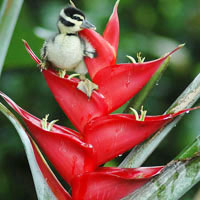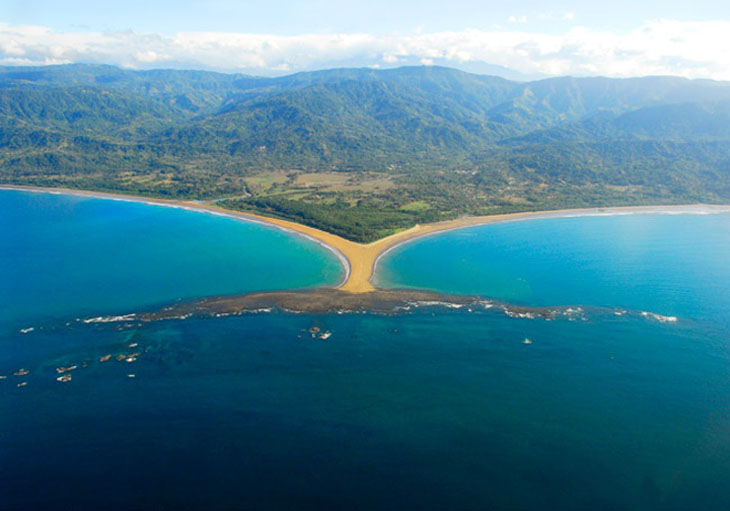|
|---|
Whale's Tail Beach Near Uvita, Just North of the Osa Peninsula - I Wonder How It Got That Name? |
Broken News
(All the News That's Fit To Reprint)
It's Snow Joke
The national futbol (soccer) teams of Costa Rica and the United States met recently in Denver for a CONCACAF game.
 |
|---|
FIFA World Cup |
CONCACAF is the World Futbol league that comprises teams from North America, Central America and the Caribbean. These countries each field national teams to compete for position on the way to the World Cup. CONCACAF is a division of FIFA, the organization that runs the World Cup, the finals for which are held every four years. Next championship? Brazil - 2014.
 |
|---|
Where's the Goal Amigo? |
 |
Either That's Ice in His hair or He Doubles as a British Solicitor |
What the Ticos didn't expect in Denver was that they'd have to play the game in near blizzard conditions. A surprise snowstorm made the field treacherous and handling the ball almost impossible.
I have no idea how you play soccer with almost a foot of white stuff on the field. I would think it would be ripe conditions for torn muscles and broken bones. If it were baseball it would be delayed to another day, football too...well, maybe not but that's why they have roofs over many stadiums these days.
Costa Rica thought there was something wrong too but they came to that conclusion too late (Tico time maybe?) After the game, in which the U.S. squeaked out a 1-0 victory, the Tico team management filed a complaint with FIFA and requested that the game be replayed. Nice try but FIFA management didn't agree and rejected the request so the result stands.
That gave the U.S. team 2 points on its way to the World Cup. In FIFA Futbol, winners get 3 points, ties give one point to each team and losers get no points. The U.S. went on the next week to gain another point when they played Mexico to a 0-0 tie in Mexico City. The Mexican home crowd, expecting a win, was not very happy with the result and a near riot ensued. Perhaps you'd rather play in Denver Mexamigos?
GG is hoping to see the next CONCACAF game between the U.S. and Costa Rica which will be played in the National Stadium in San José on September 6. It will be my first experience in the new stadium. I'll be the guy in the 53rd row waving two small flags, one U.S. and one Costa Rica. While snow is highly unlikely in San José (like zero chance), September is smack in the middle of the rainy season and this stadium is not covered, so it may turn out to be payback time for gringos.
And that's snow joke.
A recent article in an electronic newsletter mentioned two things that caught my attention. Sixaola and manatees.
 |
|---|
A Manatee |
Sixaola, of course, is the name of the town at the border crossing into Panama on the caribbean side of the country. It's also the name of a sizeable river that forms the border there. GG reported on what it was like to cross the Sixaola recently on the way to Bocas del Toro. But what I didn't know at the time was, according to the article, there are manatees living in the Rio Sixaola. That makes them the largest mammal to live within the borders of Costa Rica (the whales, of course are bigger, but they are in the sea).
Now GG is not a total stranger to Manatees. Another improvement in his poor early tropical education occurred after the move to Sarasota when he visited a well known marine animal research and rehab center called Mote Marine Laboratory. At Mote they have a couple of resident manatees named Hugh and Buffett in a large tank with glass walls as well as many other animals in captivity or various stages of recovery. In addition. there are interactive exhibits for the education of kids (like me) - petting a manta ray for example..
Hugh and Buffett weigh 1300 and 1800 pounds respectively. Some female manatees can reach over 3,000 pounds. Manatees like to spend much of their time in waterways that are close to the sea, such as Rio Sixaola, where they can feed on underwater vegetation. Hugh and Buffett on the other hand, to make up for the natural vegetation they don't get, are fed 72 heads of lettuce each day. Researchers have found, however, that manatees in the wild, when they feel like mating, will venture out into the ocean (more room for the zoom, eh).
 |
|---|
Sr. Guzman's Research Vessel |
Once when swimming about 20 yards off Siesta Key Beach, a manatee surfaced no more than 20 feet from me and snorted at me through his hairy snout. When I snorted back, he submerged again to go on his way. Kool. Manatees are gentle, normally slow moving creatures (like me), but they can move through the water at a good pace once they activate their beaver-like tails (again like me).
The article about the Costa Rican manatees further stated that there are between 100 and 150 manatees in Rio Sixaola and that they are being studied by a marine researcher named Héctor Guzmán of the Smithsonian Tropical Research Institute working in conjunction with the University of Costa Rica. Señor Guzmán has designed and equipped a rather interesting research vessel consisting of an old school bus mounted on pontoons (see picture above) that can ply the calm waters of Rio Sixaola. The boat is equipped with hydrophone arrays and other electronic devices.
So, if you find yourself crossing the border at Sixaola be sure to keep an eye out for manatees and Señor Guzmán's floating laboratory.
More on Palms & Pods
(Getting the Facts Straight About Palm Oil Production)
In the July 2012 issue, the Chronicles carried an article called Of Palms and Pods. In that piece we described how the giant farms that line much of Costa Rica's Pacific Coast produce palm oil dates and process them into palm oil, a raw material used in a wide variety of edible and non-edible products. Back then, GG made an attempt to contact the headquarters of the Palma Tica company in San José to arrange a local interview and plant tour but I was unable to reach the appropriate parties.
 |
|---|
A Lonely ROMEO Waits at the Palma Tica Front Gate |
 |
Palma Tica, Quepos Division Main Office |
 |
A Couple of Workers With Cart and Pods- Guys, Remember, the Boss Says One Dude per Cart |
A few weeks ago, two ROMEOS were engaged in our duties as senior supervisors of beach operations in Manuel Antonio when a casual contact was made with a gentlemen who was spending the day there with his family. It turned out that Señor Johan Fernández Hernández is the Superintendent of the Engineering Department.at the regional office of Palma Tica located in Damas just north of Quepos. He gave us a card and said to call for an appointment which I did and which occurred in the second week of April.
Expecting to see our beach buddy Johan at the interview, we were instead ushered into the office of the Gestor General (Social and Environmental Manager) of Palma Tica Quepos Division, Señor Carlos A. Playa C. Sr. Playa was very cordial, informative and generous with his time. We ended up spending almost two hours with him that included an audio-visual presentation of how Palma Tica is engaged in keeping its operations "green" and in being a good corporate citizen. We also got a tour of one of the farms near the Savegre river south of Quepos.
Here are some facts about Palma Tica that came out of this meeting that helped clarify what the company and business is all about:
- The current company was formed in the 1990's when United Fruit sold the plantations for $100 million to a new Costa Rican company called Numar. Yeah, that's right, the margarine company; NUMAR stands for Nutritiva Margarina (In the Queen's English, that's Nutritive Margarine but I bet you guessed that).
- There are three divisions of Palma Tica in Costa Rica, the Quepos Division, another to the south running below the Savegre and another to the north. The company also has operations in Nicaragua, Colombia and Mexico.
- The Quepos Division alone employs 1,600 people(!). With the other two divisions, total Costa Rican employment is in excess of 3,000.
- The company strives to reduce the use of agrochemicals both because of cost and environmental factors. Much of the pre and post-processing waste (known in the business as :"trash") that comes from the oil rendering process is recycled to mulch or used as biomass fuel (the Division produces about 50% of its energy needs internally)..
- The company prefers to use a cart with oxen rather than a tractor to gather the pods from the fields. It's actually cheaper because a tractor requires two men whereas the cart can operate with only one. Also, the oxen can be raised on locally grown grass cheaper than fueling and maintaining tractors. Much of the company's cost and use of pesticides is for keeping the oxen disease free, not for use on the palms or oil dates.
 |
|---|
A Palm Plantation |
 |
Palm Oil Pods Ripening on the Tree. The Brownish Cluster Top Right is the Male part of the Plant |
On the farm tour GG remarked that he'd traveled up and down the coastal highway many times over the years but it seemed the trees lining the highway never have pods growing on them. Carlos explained that most of the trees seen from that angle are older ones and are out of production but continue to be maintained as an attractive and aesthetic border to the farms. One mystery explained.
GG also tried to confirm the existence of a special new pygmy breed of palm someone told me about that made it easier for workers to extract the pods. I didn't have it quite right. The shorter palms are indeed a new breed as they grow at 1/4 the rate of the older species, and since they're relatively new, they seem to always be short but eventually they grow to normal height. The new breeds also have a productive life of approximately 40 years versus the old at 20 (business is all about productivity, eh what). Another mystery explained.
We got to examine one of the "pygmy" trees with pods nearing the ripening point. The tree has a male outgrowth (see picture) consisting of a bunch of brown spores or seed pods and a female section, the actual fruit pods. The females in the beginning produce flowers and a certain type of fly, that is attracted to the spores, transports the seeds to the flowers and completes the pollination. The deflowered pods then produce the fruit end product (sorry couldn't resist that one).
Another interesting point was how it was decided when the pods are ready for harvest. As the oil dates become ripe they turn bright orange or red and a few of them begin to drop to the base of the tree. So the pickers look down, not up and when they see a quantity of ripe oil dates, that's a signal the pods are ready for picking.
Unfortunately, the local manager of the processing plant was unavailable for a tour of his facility so we were unable to take a tour. Maybe another time amigos. Carlos did comment however, that the general outline of the processing steps GG described in the previous article (Of Palms and Pods) was essentially correct. Although a little disappointed at not seeing the "mill:" as they call it, GG found the business presentation and tour fascinating.
Thanks and a tip of the sombrero to Senores Playa and Fernandez for helping us to better understand the workings of an important industry here.
¡Buen trabajo, amigos!
Of Rain and Bugs
(The Rain Cometh - It Can Bug You)
In Costa Rica we have two seasons, referred to as Invierno (winter) or Verano (summer) but just as often referred to as the wet season or the dry season respectively. The dry or summer season runs roughly from December 15 to May 15 or five months. The other seven months are the wet or rainy season or "winter". (yet nary one snow flake shall fall in Ticoland in winter or any other time, so declare the gods).
 |
|---|
As Much as 25 Inches Here in October and as Little as a 1/2 Inch in February |
The difference between the two seasons is a startling contrast. In the January to March period we might go without a drop of rain or, like it was this year, two short showers lasting less than an hour each. The wet season, on the other hand, can raise the total annual rainfall here to five times what is experienced in the northeastern U.S. or even three times what occurs in Florida (see Singing in the Rain and also the comparative chart to the right for Quepos, Sarasota and Boston).
Most tourists and occasional visitors here have the wrong impression of what the rainy season is like in the rainforest. They envision a monsoon-like situation where heavy rains continue unbroken for weeks at a time. While we do get much more rain than the northeastern U.S. or even Florida, it's rare for it to rain all day and all night for any significant period. My recollection is that this past year we had no more than three or four days like that.
Instead what we usually get here in rainy season are sunny mornings up until early or mid afternoon when the clouds move in producing rain in the afternoon, evening or both. But what we also get is intense rain, like the old Morton's Salt tag line, "When it Rains, It Pours!". Sometimes it doesn't just pour, it becomes a deluge overloading the sizeable drainage culverts and pipes in many places, particularly in low lying Quepos.
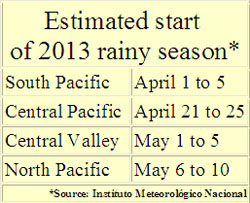 |
|---|
Each year the Costa Rica National Meteorological Institute forecasts the start of the rainy season and they have done so again for this year (see the table to the left). Note that there can be as much as a month and a half between the start of the rainy season in the south pacific and its beginning in the north pacific. Actually, we (Central Pacific) beat the date shown in the table for the Central pacific by at least 10 days.
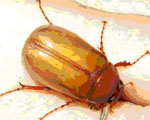 |
|---|
Tico June Bug |
The scientists at the Meteorological Institute have one method they use as a signal for the impending rainy season, the emergence of the Costa Rica June Bug. These creatures begin to appear around the last week in April (so why aren't they called April Bugs?). This year they were right on schedule supposedly signaling that this season will be normal.
The change of seasons, particularly the onset of the rainy season, can bring on new generations of a myriad of bugs (as well as an explosion of mosquitoes)..
It makes sense to pay attention to the bugs in Costa Rica because there are so many of them and they've been living here a lot longer than the humanoids so they have more practice at surviving. But the trick is to decipher and interpret what each bug knows. Costa Rica represents only about 0.03% of the world's land mass but contains in excess of 6% of the world's biodiversity. That's a disproportionate ratio of 200 to one. It's also believed that when it comes to insects the percent biodiversity here rises to more like 10%.
Here's a very small sampling of Costa Rica's bugs that are not exactly common to other places:
| A Selected Sampling of Kool Bugs Seen in Costa Rica | ||||
|---|---|---|---|---|
 |
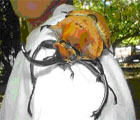 |
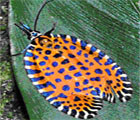 |
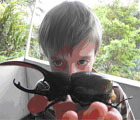 |
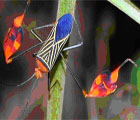 |
Don't Know the Name; How About Strawberry Moth? |
Don't Know The Name Here Either But That's a Man's Shoulder It's On |
Diurnal Moth - I'd Have Called it a Pizza Moth |
Rhinoceros Beetle How's This for Show and Tell Kiddies |
Flag Footed Beetle |
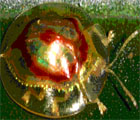 |
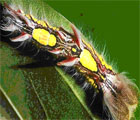 |
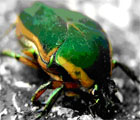 |
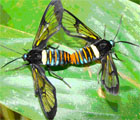 |
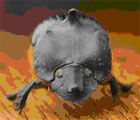 |
Tortoise Shell Beetle - Of Course |
A Caterpillar - God Knows What Kind |
It's Not Easy Being Green |
Guys - Get a Room |
Whatchu Lookin At? |
And there are virtually thousands of other creepy crawlers in Ticoland that you're unlikely to come across in New York City or Pittsburgh. Watch your step amigos.
¡Solo Bueno!
Already Got Bugs? Get a Gecko
(Forget About the Mutt as a Pet)
GG remarked in an article about Aloe Vera last month and in the article above that a boy born and raised in the northeastern U.S. has a lot to learn about living in a tropical zone. Here's another example.
 |
|---|
A Fumigadora |
If you live in a tropical or sub-tropical area you have to learn to deal with bugs. This was true in Florida and is particularly so in Costa Rica because of the strong biodiversity here - as shown above, we're home to many critters. But bugs in the home are not a celebration of biodiversity as much as they are a pain in the tucan and a potential health threat. Unlike my condo building in Sarasota, our apartment building here is not treated for insects.
The options to get rid of them are not too good. You can use a fumigation company (Fumigadora) but most working or middle class families can't afford one. Typically, they're used only in the most severe situations like an invasion of bedbugs as pictured to the right. (I've been told that if a bedbug invasion hits, the best remedy is to remove and burn the mattresses)
I live in a second floor apartment equipped with jalousie windows and no screens. I leave the windows open when I'm out of the house. This is, of course, an invitation to some creatures to join the family. Once, I returned home to find a foot and a half long iguana lizard in the middle of the kitchen floor. We had words and I chased him out, wondering how he got up to the second floor - the steps? More likely he scurried up a tree on the side of the property, then across a roof that runs below my kitchen window and then through the jalousie panes.
About a year ago I began to see more bug activity. Small ants (we called them ghost ants in Florida) began to appear on my kitchen counters and computer table in the bedroom. I immediately bought a can of raid and tried to find where they were coming in, but to no avail. I even sprayed the electrical outlets over the counter where I thought I saw some of them making a trail. I was grateful that I didn't get electrocuted. I tried to invent capture techniques like mixing some sugar in water and spreading a small puddle on the counter. In this way I could eliminate 50-100 of the micro-ants at a time, but they still kept coming back. No matter what I did, the ants kept coming back. In addition, I began to see an occasional large roach or cricket sauntering across the floor. If I could get to them quickly, Raid made short shrift of their raid.
 |
|---|
My Pal Gerry |
I was presented an answer to the problem without even asking for it. One day I returned to find a small albino gecko (about four and a half inches from nose to the tip of his tail) attached to the middle of the kitchen wall. When I got closer he scurried to cover. Then, over the next few weeks, the ants disappeared and the crickets and roaches as well. It finally dawned on me that my new friend (Gerry) might be the one responsible for the insects' demise. I looked up info on geckos and found they do indeed like to consume insects and that a cricket is like a prime steak to them. Yum.
 |
|---|
Gecko Family Reunion |
As time progressed I began to talk to Gerry in gecko talk; after all any diversion in retirement is welcome. He makes a thyack, thyack, thyack sound two or three times a day usually from behind my bed, which is situated in a corner so he feels safe there, or from behind a cabinet in the kitchen. I respond with as similar a sound as I can make, telling him how much he's appreciated and that he should keep up the good work.
So now I have a pet and buddy named Gerry. He's the best kind of pet possible; he brings me benefits I don't need to ask for, he does not require me to buy mucho kilos of canned or dry food and when I go on vacation or a trip anywhere I don't have to worry about parking him at a shelter or having someone come in to pet sit. My only concern is that Gerry will run out of insects and move on, or that Gerry could turn out to be Geraldine and produce a litter of new little albino lizards and I could have a problem dealing with a different kind of invasion.
Oh my, the trials and tribulations that come the way of the retired person.
¡Pura Vida!
Raising Cane
(How Sweet It Is)
Despite all the concerns about eating too much sugar and the rising epidemic of diabetes and obesity around the globe, worldwide per capita consumption of sugar has increased over 12% in the last ten years. Current consumption is on the order of 24 kilos (about 53 pounds) per person per year. Holy cavities, amigo, that's more than 10 of those 5 lb sacks you see in the supermarket for each of us! And, I suspect, the number is higher in developed (U.S.) and developing (Costa Rica) countries, pulling up the average.
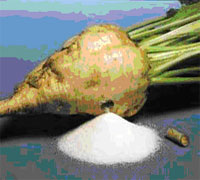 |
|---|
Sugar Beet - No the Sugar Didn't Just Pour Out of the Beet - Just an Illustration |
 |
Man Cutting Cane with a Machete |
 |
Cut Sugarcane Stalks |
Once I was traveling by train from Belgium into France along with a French colleague. I was looking out the window at the passing farms when I asked my friend what crops might be growing there. "Zose are zyugar beet farms, mon ami." Beets? Says I? I thought sugar came from sugarcane like the name suggests. "Ah qui, cher ami, but in Europe it comes from beets". One can learn something even while sitting on a train eating breakfast.
The earliest written records and hieroglyphics refer to processing cane for it's juice and extracting the crystalline material that comes from boiling or drying out the juice. Records go back to at least 2000 BC in Egypt and as much as 4000 years in the orient that show people making sugar from sugarcane. The making of sugar from beets goes back nearly as far.
The basic reason for beets versus cane in Europe was the existence of a wild sugar beet that grows along the coast of France and England. Over the eons, the root was discovered to be renderable into sugar. The early varieties contained 5-6% sugar while the modern hybrid versions have about 20%.
But in the Americas, including the United States, the Caribbean and Latin America, most sugar comes from sugarcane. Brazil is by far the largest producer of sugarcane accounting for over one third of total worldwide production. India and China are the next largest producers accounting for 16% and 7% of world production respectively. The U.S. share is 1.5% and Costa Rica comes in at 0.2% of world production.
Sugarcane is a woody stalk that grows in tight formation. Although most of it these days is harvested by machine there is still a significant amount gathered by hand using a machete as pictured to the right. There is some argument and discussion these days about one of the steps used in the raising and gathering of sugarcane, namely the burning of the fields before harvesting.
Sugarcane produces a large amount of ruffage at the base of the plants. Burning the fields before harvesting reduces this trash, or "bagasse" as it is called, making the harvesting much easier. The ability to extract the sugar liquor is not effected by the controlled burnings. Burning also reduces the amount of post processing bagasse that manufacturers have to deal with. The negative side, of course, is that all this burning produces a lot of smoke and, as civilization encroaches, the smoke produces more complaints by those doing the encroaching.
The processing of sugarcane to extract its essence is straightforward. The stalks are washed and crushed to render the sweet process liquor. The juice is then filtered and impurities removed. After this, it can be made into the products described below. The crushed stalks and their residual fibers are used in many different ways also noted below.
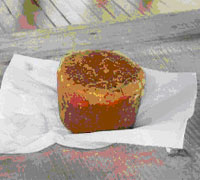 |
|
|---|---|
A Brick of Tapas de Dulce |
|
 |
 |
Sugarcane Work Duds |
|
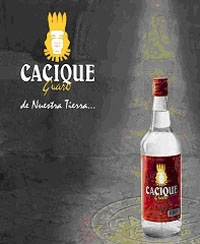 |
|
The Guaro of Costa Rica |
|
 |
|
A Quepos Town Elder Who's Had One Too Many Cuchumbas - Can You See the Empty in His Belt? |
|
In modern plants, 10 tons of cane produces 3 tons of bagasse, which is further processed into a biomass fuel for use in the sugar refinery. Other uses for bagasse include mulch, paper production and, after a kind of fermentation process, it is used as an animal feed, particularly in the far east (gotta believe fermented feed makes happy cows).
In addition to producing typical refined sugar that we buy in the stores, the sugarcane extract, filtered, can be used to make an unbleached sugar product common in Costa Rican food stores and called "tapas de dulce". Ticos have been making confectionaries from this product going back to the early native indians. The country historically was dotted my many mom and pop cane processing farms producing tapas de dulce but the number is now dwindling. For more on this product, tradition and culture see Tapas de Dulce
Fibers from sugarcane stalks can also be used in the manufacture of clothing. The Japanese spearheaded this application and produced a quality denim from sugarcane. It makes a fabric suitable for work shirts and pants or just for casual sportswear if you like. A similar fabric called chambray, which had its origins in France, can and often is made of sugarcane fiber.
And of course, if any plant or fruit can produce any type of sugar, man's instinct since time immemorial has been to ferment it into some kind of mind-bending spirit. (My guess is Adam and Eve got into hard apple cider not long after they inherited the orchard - the devil made them do it).
Sugarcane extract has been no exception. One common product from its fermentation is a clear distillate with a 70 proof kick called "guaro". The national brand name for guaro in Costa Rica is Cacique (cah-see-kay). It's not only the national brand but actually the only legal brand as guaro production is limited to a government owned and operated factory.
Guaro is relatively easy and cheap to produce, so for years there were almost as many stills in the countryside as there were cane farms. It was sort of like riding through the back hills of Kentucky, Tennessee and West Virginia. In order for the government to get the upper hand (these party poopers are similar to the U.S. ATF), the Costa Rican government outlawed production except by themselves.
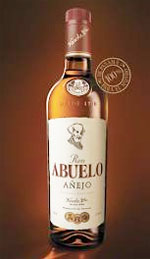 |
|---|
Ron Abuelo 0r "Grandpops Rum" |
That's not to say people don't make a little home brew here and there but the government plant is so efficient that it's usually easier and cheaper to buy the legal stuff. A 500 milliliter bottle of Cacique (this size is also known by the nickname "cuchumba") is only about 1,500 colones or $3. That's $3 for about 17 ounces of a 70 proof liquor - a really cheap drunk. No wonder cuchumbas are the favorite of the local town borachos (see photo left).
In addition to guaro, the sugar liquid from cane can be made into molasses from which cometh rum. The word for rum in Spanish is "ron". Ron Abuelo, (Grandad's or Grandfather's Rum) is a Panamanian based company and is one of the best known brands in Central America.
Securing sugar and its products was the main reason why the British, French and Spanish (sometimes the Dutch and later the Americans) sparred over owning the islands in the caribbean. It wasn't that they liked the beaches so much as they wanted to control the sugar plantations and, consequently, the molasses and rum trade.
So the next time you pass a farm growing sugarcane think of how versatile that stuff has become for mankind. And watch out for the cuchumbas.
¡Pura Vida!
What's-in-a-Word
Bagasse (bah-gas)
 |
|---|
Disposable Dinnerware Made from Bagasse is Biodegradable |
My handy-dandy online dictionary defines it this way:
"the pulp remaining after the extraction of juice from sugar cane or similar plants (e.g., beets - ed.) used as biofuel for or raw material for making paper"
The word has roots in both Spanish and French (both use "bagazo") and may have originally come from the latin "baca", The connotation in all of these original terms relates to husks, dregs, refuse or waste.
The fibers from bagasse can be formed into a myriad of products as described in the article Raising Cane above.
Cuchumba
As far as I can determine, this word was constructed as a nickname for a small bottle of Cacique and holds no other meaning in Spanish nor has an equivalent in English. Yet, say "I need a cuchumba" to any Tico and they'll smile and immediately know what you're talking about.
ROMEO Corner
(Retired Old Men Eating Out)
"Z" - Manuel Antonio
Location: In Plaza Yara, about a third of the way up the main road to Manuel Antonio from Quepos, half way between the Hotels Mono Azul and Gaia on the left (same location as former restaurants SALT and La Hacienda).
Hours: Monday thru Sunday 6-10 PM
Parking: Sufficient in front of the restaurant.
Contact: Tel.: 2777-6948; Email: info@Zsealounge.com; Website: www.Zsealounge.com
Reviewing ROMEOS: Jim M., Brian M., Tony R., Duston R., Bob N.
To Review Our Rating System and Procedure, go here: R.O.M.E.O. Rating System
This is a new restaurant hoping to overcome the stigma of two others (SALT and La Hacienda) that didn't make it in this location in recent years. After sampling Z, we all hope this one will change that record.
 |
|---|
The new place is operated by a very personable couple, he Canadian in origin and she Belgian. The dining room has been redecorated in an off white motif with blue accents and good indirect lighting that was still strong enough for old cataract Bob to read the menu (a personal peeve).
Interestingly, the dining room floor was covered with a light colored sand that was not slippery underfoot and also seemed to provide a bit of sound absorption. We sat at a rectangular booth with table easily big enough for five of us. The booth was well padded and equipped with throw pillows making the seating as comfortable as possible (another GG peeve). The table was covered with a heavy off-white oil cloth and the ceiling was gently lined with a translucent fabric gently lit from above. Low music played from the speaker system and didn't interfere with our conversation. This dining room is open on two sides to the jungle and we were entertained with the sounds of the bosque during the time we were there including a few times when the howler monkeys growled at us.
For atmosphere we give Z our top rating - five sloths.
To start, we were offered complimentary fried tortilla points with a pleasant avocado-based spread. Very tasty. The entree selections for the evening are posted on a white board on the wall. The night of our visit, there were only seafood items on the menu. The owner later told me that the restaurant is not restricted to seafood only; it's just that the best and freshest buys, his overriding criterion, were all in the seafood line that day. In addition to the specials, the menu consists of a list of "share" items for 1, 2 or 5-6 people ranging from an antipasto to several hot and cold seafood choices. To start, two ROMEOS shared an antipasto that contained prosciutto, spiced salami, ham, fried slices of eggplant and zucchini, roasted sweet peppers, all drenched in olive oil and sprinkled with cashews. Delicious. |
 |
|---|---|
$$$$ |
|
Value Index = 125 |
 |
|---|
| Tuna Filet With Mussels |
For that night's main course specials, two of us chose penne pasta with shrimp (each bowl was also decorated with a few langoustines), two chose the the pan-seared tuna filet with mussels accompanied by potato wedges and crisp fried vegetables and one chose a mahi-mahi with a delicate sauce.. All ROMEOS commented on how fresh, tasty and well presented the food was.
Of course, GG couldn't control himself and had to ask for the dessert menu, at which point we were treated to a nice display of chocolate desserts. We all had one or another, yum-yumming all the time. We give Z five sloths for food quality.
It was a pleasant surprise that several of us knew our waiter, an old Tico friend. Our service was attentive and friendly. The kitchen was a trifle slow on the main courses but good food just takes time and with good friends, good conversation ensued to take up the time. Our waiter didn't even grimace when we imposed our usual irritation of asking for five separate checks. We give Z five sloths for service, making our overall rating for atmosphere, food quality and service a full five sloths.
For my antipasto, tuna filet with mussels, a chocolate truffle concoction and two soft drinks my tab came in at around 18,000 colones ($35). The pasta dishes with dessert and soft drinks came in around 13,000 colones ($25). This puts Z about 3/4 of the way up our price index - we settled on an overall cost rating of 4$. This gives Z a Value Index of 5 sloths/$4 = 125, putting it neat the upper one third of restaurants reviewed so far.
The ROMEOS came away from Z hoping the place will be around for a long time.
Give Z a try, you won't be disappointed.
don Beto de Quepos,
El Gringo Dorado ¡Pura Vida! |
Be pithy but kind. I'm sensitive. |
|---|
